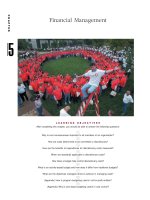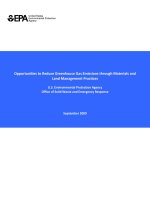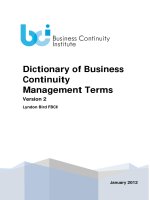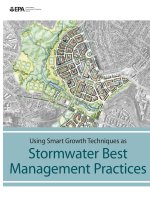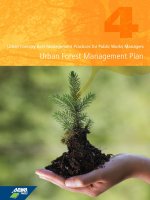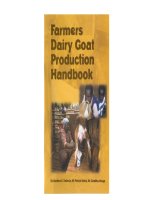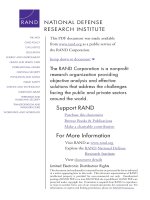DOE Financial Management Handbook doc
Bạn đang xem bản rút gọn của tài liệu. Xem và tải ngay bản đầy đủ của tài liệu tại đây (281.48 KB, 47 trang )
DOE Financial Management Handbook 7-18-2011
Chapter 10-1
CHAPTER 10
PROPERTY, PLANT, AND EQUIPMENT
1. INTRODUCTION.
a. Background/Authorities. This chapter describes financial controls over
the acquisition, use, and retirement of property and provides guidelines for
distinguishing between charges to capital accounts and charges to expense
accounts consistent with the Statement of Federal Financial Accounting
Standards (SFFAS).
b. Applicability. The applicability of this chapter is specified in Chapter 1,
“Accounting Overview.” When in conflict with the provisions of this
paragraph, power marketing administrations (PMAs) should observe the
policies of the Federal Energy Regulatory Commission and other industry
standards as they apply to the accounting and financial management of
property, plant, and equipment (PP&E).
c. Policy/Objectives. Financial accounting for PP&E should be governed by
the following basic principles:
(1) Department of Energy (DOE) property should be accounted for
and reflected in the official DOE financial records in accordance
with the capitalization criteria contained in this chapter, regardless
of funding source;
(2) Depreciation should be calculated and recorded in the appropriate
cost-of-operation account, using the appropriate fund type;
(3) Timely and accurate financial reporting on facility construction
and capital equipment activities should be provided to DOE
management;
(4) Financial control over property should be maintained;
(5) The primary basis of accounting for property is its acquisition cost
(with the general exceptions of transfers, excess property received,
foreclosures, and discoveries); and
(6) Common-use temporary construction facilities and equipment
should be budgeted for by the Landlord Program without
chargeback to the benefiting construction projects.
d. Capitalization Criteria.
(1) Capitalization Threshold. The capitalization threshold for items
acquired prior to October 1, 2011 is $50,000. For items acquired
on or after October 1, 2011, the threshold is $500,000.
(2) Capitalize individual PP&E items that are purchased, constructed,
or fabricated in-house, including major modifications or
improvements to any of these items, if they have an anticipated
service life of 2 years or more and if they cost more than the
capitalization threshold regardless of funding sources (see
paragraph (a) below). The only exceptions are items that are
inherently experimental, used as special tools, or, by nature of their
association with a particular scientific experiment, not expected to
have an extended useful service life or an alternative future use.
Notwithstanding the accounting threshold for physical
accountability/control purposes, personal property records are
required for items of personal property with an acquisition cost of
$5,000 or more. Data about real property, regardless of value,
should be retained in the Facility Information Management System
(FIMS) required per Title 41 CFR 101-47.201.2.
(a) Purchased Assets. Generally, costs should be
recorded net of purchase discounts taken. Purchase
discounts lost and late-payment penalties should not
be included as costs of assets, but should be written
off as an operating expense. Capitalized cost includes
all costs to convert or to make the facilities or
equipment ready for use, for example, invoice price,
transportation, and installation costs. As a general
rule, indirect costs associated with the purchase of the
item are not capitalized.
(b) Constructed Assets. When an entity constructs a
depreciable asset for its own use, all direct costs are
included in the total cost of the asset. Constructed
capital assets must receive their allocable share of all
indirect costs (CAS 404).
(c) Purchased Asset Improvements. When the
expenditures that increase the capacity or operating
efficiency or extend the useful life of an asset are
substantial, expenditures are capitalized. Capitalized
cost includes all costs to convert or to make the
facilities or equipment ready for use, for example,
invoice price, transportation, and installation costs.
DOE Financial Management Handbook 7-18-2011
Chapter 10 Property, Plant, and Equipment
Chapter 10 - 3
Minor expenditures usually are treated as period costs
even though they may have the characteristics of
capital expenditures.
(3) For capitalization of automated data processing software, follow
directions contained in a November 20, 2000 memorandum issued
by the CFO. Apply the capitalization threshold in effect at the
time the software is acquired or completed.
(4) Capitalize and group in a separate asset-type account related items
that individually cost less than the capitalization threshold but that
collectively cost more than the capitalization threshold, such as the
initial complement of equipment (for example, office equipment)
for a building, if current costs would be distorted in a given period
by charging such items to expense accounts. The initial
complement of equipment of insignificant value relative to total
project cost is generally distributed over the cost of the property
record units to which it is related.
(5) Capitalize property, including assets acquired through installment
contracts and lease purchases, as described in this chapter.
(6) Generally, DOE elements should not capitalize interest during the
acquisition of PP&E. However, certain DOE elements fund the
acquisition, construction, or fabrication of PP&E through direct
borrowing from the Department of the Treasury (Treasury) and
pay interest directly to Treasury. In such cases, capitalize interest,
if it is material, based on the interest rate charged by Treasury for
the funds borrowed. The interest capitalization begins with the
first expenditure for the qualifying asset and ends when the asset is
substantially complete and ready for its intended use. Capitalize
interest costs as long as the following general conditions are met:
(a) Expenditures for PP&E have been made, and
(b) Activities that are necessary to get PP&E ready for its
intended use are in progress.
e. Property Record Unit Concept.
(1) Property record units are designed to establish divisions of the
completed PP&E categories. Property record units facilitate the
recording of changes to property categories and the reconciliation
of physical inventories with financial accounts.
DOE Financial Management Handbook 7-18-2011
Chapter 10 Property, Plant, and Equipment
Chapter 10 - 4
(2) A property record unit, sometimes called a PP&E record unit, is a
plant or equipment item, for example, a building, selected to be
continuously identified in the property records. The selection of
property record units determines the manner in which costs are
assembled and recorded in the property records. A property record
unit may be composed of one or more retirement units. In
selecting the property unit, consideration should be given to its use,
relationship with other associated items, relative importance,
frequency of anticipated property changes, and monetary value.
Generally, $50,000 or more is considered sufficient monetary
value to justify maintaining continuing records of the property unit.
A property record unit may be a functional unit consisting of an
assembly of associated items, some of which are retirement units,
such as a hydraulic extrusion press; a facility serving or designed
to serve two or more other property record units, such as a control
system or piping system; a continuous facility of which sections
are retirement units, such as roads, walks, and paved areas; or a
unit that is complete in itself, such as a spectrometer.
(3) Retirement units are established for convenience in accounting for
the replacements of major components of plant and equipment.
(a) A retirement unit establishes a physical dividing line by
which costs of major work related to plant and equipment
are capitalized. Costs to extend the life of or replace the
retirement unit should be capitalized. All other costs
related to the retirement unit should be expensed. A
retirement unit is a component of plant and equipment that
is capitalized in a separate account and invariably
eliminated from the plant and equipment accounts when
removed, transferred, sold, abandoned, or demolished.
(b) There should be a close coordination among the budget,
accounting, engineering, project management, and
technical staffs in the development and maintenance of
retirement units. The development of retirement units
should take into consideration such factors as use made of
the item, retirement history of identical or comparable
items, and the monetary and physical relationship of the
item to the associated property record unit. Although items
identified as retirement units are capitalized in the
accounting records, from a budgeting perspective, the
substitution of a new retirement unit of essentially the same
type and performance capabilities as the replaced
retirement unit should be funded out of operating funds.
DOE Financial Management Handbook 7-18-2011
Chapter 10 Property, Plant, and Equipment
Chapter 10 - 5
However, the substitution of a new retirement unit having
significantly improved and superior performance
capabilities beyond those of the replaced retirement unit is
considered betterment and should be funded out of capital
funds.
(4) Each field element or integrated contractor will develop and
maintain its own property record unit catalog or one that may serve
all activities reporting to that element. Approval by the head of the
field element or a designee is necessary for new catalogs and
revisions of sections of existing catalogs. DOE review and
approval of property record unit additions and deletions by
contractors should be done annually by the cognizant field Chief
Financial Officer (field CFO). A property record unit catalog
describes the property record units that DOE owns. It provides a
basis for a common understanding as to the manner in which PP&E
costs are assembled and recorded in the field and contractor PP&E
records. The description of each property record unit is intended to
provide sufficient information to identify the unit in the PP&E
records and for physical inventory purposes. The retirement units
applicable to each property record unit provide a basis for
distinguishing between capital (PP&E) and expense charges. A
property record unit catalog should have the following principal
features:
(a) An explanation of the property record units, what they
consist of, and the descriptions used and type of asset;
(b) The manner in which the units are to be recorded in the
property records, whether as individual items or as a group
of similar items;
(c) A list of the retirement units applicable to each property
record unit; and
(d) The current Departmental capitalization criteria.
f. Guidelines for Distinguishing Property, Plant, and Equipment
Expenditures from Operating Expenditures.
(1) Although operating expenditures and PP&E expenditures are now
consolidated under the same appropriation, separate functional
classifications are required, and the distinction between operating
and PP&E expenditures must be maintained at all levels of
procuring, accounting, and reporting.
DOE Financial Management Handbook 7-18-2011
Chapter 10 Property, Plant, and Equipment
Chapter 10 - 6
(2) Consider the following two factors in determining whether an
action should be classified as PP&E: the nature of the item to be
purchased or constructed and the service life and cost of the item to
be purchased or constructed. Budget and procurement procedures
should ensure that PP&E procurements are properly matched
tocorresponding funding ceilings. The various types of PP&E
items may be categorized broadly as follows:
(a) Plant.
1. Land includes land rights, depletable resources
(minerals and timber), and improvements to land.
2. Buildings include all structures, additions, or
improvements to structures (but not normal
maintenance).
3. Construction includes all elements associated with
construction in progress.
4. Utilities include water and sewage systems; heating,
cooling, and power systems; communications
systems; and fire prevention systems.
(b) Equipment.
1. Heavy equipment includes all vehicles, railroad
stock, processing or manufacturing machinery, shop
machinery, reactor or accelerator machinery, and
reserve construction machinery.
2. Special and scientific equipment includes medical,
laboratory, and security equipment.
3. Automated data processing equipment includes
computers, printers, cathode ray tubes, operating
system software, and interface peripherals.
(3) The following are examples of costs that are expensed:
(a) Plant.
1. Land. Expense normal maintenance and repair,
such as periodic vegetation control, repairs to
DOE Financial Management Handbook 7-18-2011
Chapter 10 Property, Plant, and Equipment
Chapter 10 - 7
sections of sidewalks, and roads that are less than a
retirement unit.
2. Buildings. Expense normal maintenance and repair,
such as painting, cleaning and small repair jobs not
resulting in an addition, replacement of a retirement
unit, or a betterment. Alterations are also expensed.
3. Construction. Expense demonstration plants that
have limited service lives and that will not be used
for actual production or operations.
(b) Equipment.
1. Expense equipment not meeting the capitalization
criteria.
2. Expense conceptual design, fabrication, testing, and
reworking of prototype equipment subject to
redesign as fabrication and testing are performed.
This usually applies only to the first unit if several
similar units are to be acquired.
3. Expense testing and reworking of prototype
equipment for which design has been established.
(4) The appropriate funding source (operating or PP&E) can also be
determined by relating funding needs to specific project activities
as defined below (detailed description of the services provided can
be found in DOE Order 413.3A, “Program and Project
Management for the Acquisition of Capital Assets”):
(a) Initiation Phase. During this phase, preconceptual planning
activities focus on the Program’s strategic goals and
objectives. User needs are analyzed for consistency with
the Department’s strategic plan, Congressional direction,
administration initiatives, and political and legal issues.
One outcome of the analysis could be a determination that a
user need exists that cannot be met through other than
material means. This outcome leads to the development and
approval of a Mission Need Statement.
(b) Definition Phase. Upon approval of mission need, the
project enters the Definition Phase where alternative
concepts, based on user requirements, risks, costs, and
DOE Financial Management Handbook 7-18-2011
Chapter 10 Property, Plant, and Equipment
Chapter 10 - 8
other constraints, are analyzed to arrive at a recommended
alternative. This is accomplished using Systems
Engineering and other techniques and tools such as
alternatives analysis and Value Management/Value
Engineering. This ensures the recommended alternative
provides the essential functions and capability at optimum
life cycle cost, consistent with required performance, scope,
schedule, cost, security, and environment, safety and health
considerations. During this phase, the required Value
Management assessment is completed, and more detailed
planning is accomplished which further defines required
capabilities. The products produced by this planning
provide the detail necessary to develop a range of estimates
for the project cost and schedule.
(c) Execution Phase. Following the Definition Phase,
preliminary design activities mark the beginning of the
Execution Phase. Systems Engineering continues to
balance requirements, cost, schedule, and other factors to
optimize the DOE O 413.3A design, cost, and capabilities
that satisfy the mission need. Engineering and design
continue until the project has a sufficiently mature design
that can be implemented successfully within a firm
Performance Baseline. During this phase, the initial design
concepts and the preliminary design are developed into
detailed and final designs and plans. These plans are used
to procure or manufacture components, fabricate
subsystems, or construct, remediate, decommission or
demolish facilities. Major activities in this phase include:
1. Establishing Performance Measurement Baselines
and implementing change control procedures;
2. Satisfying environmental and safety requirements;
3. Obtaining approved National Environmental Policy
Act documentation, if required, prior to the start of
detail or final design;
4. Continuing to refine and optimize cost estimates,
schedules, and designs;
5. Approving the final design for procurement and
implementation; and
DOE Financial Management Handbook 7-18-2011
Chapter 10 Property, Plant, and Equipment
Chapter 10 - 9
6. Identifying and addressing security concerns.
Execution comprises the longest and most costly
phase of a project. Value Management and Value
Engineering are implemented throughout the project
Execution Phase to ensure the most effective
solutions are implemented. If the delivery method is
Design-Build versus Design-Bid-Build and a single
contract is awarded for both design and
construction, it may be necessary to tailor the
project’s execution process to allow the project
team to propose cost-effective innovative
approaches that reduce project duration and cost.
(d) Transition/Closeout Phase. When the project nears
completion and has progressed into formal transition and
commissioning, which generally includes final testing,
inspection, and documentation, the project is prepared for
operation, long-term care, or closeout. The nature of the
transition and its timing depends on the type of project and
the requirements that were identified subsequent to the
mission need.
g. Accounting for Repair, Maintenance, Alterations, and Betterments.
(1) Repair is the restoration or replacement of a deteriorated item of
PP&E, such that it may be utilized for its designated purpose. The
cost of repair, which is normally charged to an operating expense
account and includes amounts for labor and associated supervision
and materials, as well as indirect and other costs incurred in such
repairs, may include the costs to replace items of PP&E designated
as retirement units. (PMAs should refer to publications and studies
on utility plant service lives.)
(2) Maintenance is the recurring day-to-day work that is required to
maintain and preserve PP&E in a condition suitable for it to be
utilized for its designated purpose. It differs from repair in that it
is normally worked to correct wear and tear before major repair is
required, and it is usually less involved than repair work.
Maintenance work is typically also charged to an operating
expense account. Preventive maintenance is a specialized category
for the broader category of maintenance and is typically charged to
an operating expense account.
(3) Alterations are adjustments to interior arrangements or other
physical characteristics of an existing property record unit so that it
DOE Financial Management Handbook 7-18-2011
Chapter 10 Property, Plant, and Equipment
Chapter 10 - 10
may be more effectively adapted to or utilized for its designated
purpose. It does not result in a betterment to the property record
unit. The following are examples of alterations:
(a) Removal or installation of interior walls for purposes of
rearranging the layout of an office building, and incidental
heating and ventilation ducting system modifications that
do not significantly extend the capacity of the system;
(b) Construction of a door or passage through an interior
structural wall; and
(c) Installation of new lighting fixtures that do not significantly
increase the lumens emitted but may result in energy or
maintenance savings.
(4) Betterments are improvements to PP&E that result in better
quality, higher capacity, or an extended useful life, or work
required to accommodate regulatory and other requirement
changes. Betterments are capitalized. Determining when and to
what extent an expenditure should be treated as a betterment
requires judgment. When a minor item is replaced in each of a
number of similar units, the costs, is the proper basis for
determining whether or not a betterment is effected. Although a
particular project may meet the characteristic of a betterment, if the
capitalization criteria are not met or the improvement added is
insignificant, then the project should be expensed. Listed below
are various terms which are commonly used to describe various
categories of betterments:
(a) Construction is the erection, installation, or assembly of a
new plant facility; the addition, expansion, improvement, or
replacement of an existing facility; or the relocation of a
facility. Construction includes equipment installed in and
made part of the facility and related site preparation;
excavation, filling and landscaping, or other land
improvements; and the design of the facility. Examples of
improvements of an existing facility include the following
types of work:
1. Replacing standard walls with fireproof walls;
2. Installing a fire sprinkler system in a space that was
previously not protected with a sprinkler system;
and
DOE Financial Management Handbook 7-18-2011
Chapter 10 Property, Plant, and Equipment
Chapter 10 - 11
3. Replacing utility system components with
significantly larger capacity components (for
example, replacing a 200-ton chiller with a 300-ton
chiller) and converting the functional purpose of a
room (for example, converting an office into a
computer room).
(b) Conversion is a major structural revision of a facility that
changes the functional purpose for which the facility was
originally designed or used.
(c) Replacement is a complete reconstruction of a plant record
unit that has deteriorated or has been damaged beyond the
point where its individual parts can be economically
repaired. If the item replaced is a retirement unit, its
original costs (including installation cost) are removed
from the PP&E categories, and the cost of the newly
installed item (including installation cost) is added to the
PP&E categories.
h. Plant and Equipment Changes.
(1) Construction Work in Progress. The Construction Work in
Progress account includes costs of additions and retirements of
PP&E that is in progress and is being accumulated during the
acquisition or construction period. The acquisition cost of
construction work in progress should be closed to the completed
PP&E categories when the equipment and facilities are placed in
service (that is, beneficial occupancy) even if the entire project is
not financially completed. The acquisition cost of items being
retired should be closed to the appropriate accumulated
depreciation account when items are actually disposed of. All
costs that relate to PP&E changes in progress and the cost of
unconsumed construction materials, supplies, and temporary
construction facilities should be included in the account. Detailed
accounting records should be maintained for the following (when
work is performed under cost-type contracts, the detailed
accounting records for each project or job should be further
subdivided to facilitate cost control and to make entries to PP&E
categories and continuing property records):
(a) Each construction project or job, for example, construction
materials and supplies, construction equipment, and
temporary facilities, and
DOE Financial Management Handbook 7-18-2011
Chapter 10 Property, Plant, and Equipment
Chapter 10 - 12
(b) Each type of capital equipment.
(2) Demolition, Dismantling, and Removal Costs and Salvage
Credits. Removal costs should be accounted for as Construction
Work in Progress when the removal is in connection with an
authorized construction project or an equipment project and when
one of the following conditions is met:
(a) Costs are incurred when it is economical to salvage or reuse
items;
(b) The removal is necessary for health and safety
considerations; or
(c) Contractual agreements require removal.
(3) Abandoned Projects. Project costs should include costs incurred
because of the cancellation of all or part of a contract or purchase
order to procure, manufacture, or assemble an item of PP&E.
These costs, less any salvage credits, should be distributed over the
remaining units of property within the project for project
accounting purposes, except where such distribution significantly
distorts the cost of the remaining property units. Where such
distortion occurs, the costs of the abandoned project or project
segment may be closed from Construction Work in Progress to
Abandoned Projects. All charges to abandoned projects should be
approved by the head of the field element.
i. Responsibilities.
(1) Integrated contractors should be required to maintain summary
financial control records for their subcontractors having DOE-
owned property in their possession, and DOE field elements should
do the same for all integrated and offsite nonintegrated contractors
for which they are responsible. Property records should facilitate
control of the costs of work in progress and should indicate
whether an item has been capitalized or not. The summary
financial control accounts maintained by DOE field elements and
integrated contractors should include as a minimum the reporting
code of the organization holding the property, the site code, the
type of property (asset type), the acquisition cost, the accumulated
depreciation, and the use status code. DOE field elements and
integrated and nonintegrated contractors must maintain accurate
and up-to-date accounting records to provide the proper
DOE Financial Management Handbook 7-18-2011
Chapter 10 Property, Plant, and Equipment
Chapter 10 - 13
accountability for DOE’s investment in property. As property is
acquired, transferred, retired, or otherwise taken out of service
because of loss, consumption, or casualty, documentation should
be prepared, retained, and used to support entries into the
accounting records, to authorize disposals and transfers, and to
explain total or partial losses of property.
(2) Three offices are responsible for establishing DOE policy for
property management: the Office of Chief Financial Officer, the
Office of Engineering and Construction Management, and the
Office of Procurement.
(a) The Chief Financial Officer (CFO) carries out property
accounting responsibilities through the Office of Financial
Policy, which develops accounting policies and procedures
related to appropriated funds and fiscal policies for
exercising stewardship over the Department’s assets.
(b) The Office of Engineering and Construction Management
serves as the Department’s official point of contact relating
to the acquisition, use, or disposal of real property.
(c) The Office of Procurement is responsible for property
management through the promulgation of acquisition
regulations and financial assistance rules governing DOE
property held by contractors. In addition, the Property
Management Division develops and maintains procedures,
standards, and guides for property, supply, and equipment
management programs; for personal property management;
and for the Defense Production Act of 1950 priorities and
allocations program.
2. REAL PROPERTY.
a. Definitions.
(1) Real property includes land, improvements on the land, or both, and
interests therein. The chief characteristics of real property (real estate)
are immobility and tangibility. It comprises land and all things of a
permanent and substantial nature affixed thereto, whether by nature or
by “human hand.” By “nature” is meant trees, the products of land,
and natural resources; by “human hand,” those objects, buildings,
fences, or bridges that people erect upon the land. Equipment or
fixtures, such as plumbing, electrical, heating, built-in cabinets, and
elevators, that are installed in a building in a more or less permanent
DOE Financial Management Handbook 7-18-2011
Chapter 10 Property, Plant, and Equipment
Chapter 10 - 14
manner usually are held to be part of the real property. Real property
may also include triple-wide trailers or modular units joined together
so that the structure is not portable and cannot be relocated without
being dismantled and thus losing its identity. Trailers double-wide or
less, used as temporary or mobile facilities should be considered
personal property when not acquired or intended for permanent use.
(2) Related personal property is any personal property that is an integral
part of real property or is related to, designed for, or specifically
adapted to the functional or productive capacity of the real property,
the removal of which would significantly diminish the economic value
of the real property or the related personal property itself. Examples
of related personal property are communication systems and telephone
systems. Normally, common-use items, including but not limited to
general-purpose furniture, utensils, office machines, office supplies,
and general-purpose vehicles, are not considered related personal
property.
b. Financial Controls Over Real Property. Detailed records of DOE-
owned property should be maintained by the DOE field element, or by a
designated contractor. The only exception to this requirement is that
Government-owned land and land rights should be included in the detailed
records of the responsible DOE field element. The summary financial
control records maintained by field elements and contractors should
include, at a minimum, the reporting code of the organization holding the
property, the site code, the type of property (asset type), the acquisition
cost, the accumulated depreciation, and the use of status code. Accurate
and up-to-date accounting records should be maintained to provide the
proper accountability for DOE’s investment in property. As property is
acquired, transferred, retired, or otherwise taken out of service because of
loss, consumption, or casualty, documentation should be prepared,
retained, and used to support entries into the accounting records, to
authorize disposals and transfers, and to explain total or partial losses of
property.
c. Purchase of Real Property is accounted for as follows:
(1) The cost of land and land rights includes the purchase price, other
acquisition costs, and net costs of removing or wrecking any
facilities acquired with the land.
(2) The cost of completed facilities purchased from non-Government
sources includes the purchase price, other costs incident to the
purchase, and the net cost of converting the facilities to make them
DOE Financial Management Handbook 7-18-2011
Chapter 10 Property, Plant, and Equipment
Chapter 10 - 15
useful to DOE. Exceptions to this policy must be authorized by
the CFO.
d. Improvements to Property of Others. The Comptroller General has
established as Government policy that, in general, the Government may
not make permanent improvements to non-Government-owned land. The
basic premise on which the Comptroller General has allowed exceptions to
the policy against permanent improvements to private property is whether
the Government’s interests in the overall project are adequately protected
with respect to such improvements. In making such a determination, the
Comptroller General has established the following general criteria that
must be addressed in order to allow the use of Federal funds for such
improvements:
(1) The expenses of the improvements are nominal in comparison with
the total price of the contract;
(2) The improvements are incident to and essential for the
accomplishment of the authorized purpose of the appropriation;
and
(3) Improvements are used for the principal benefit of the Government
(46 Comp. Gen. 26, 27, (1966); 42 Comp. Gen. 480 (1953)).
e. Leasing. A lease is an agreement conveying the right to use an asset or
part of an asset (such as part of a building) from one entity (the lessor) to
another (the lessee) for a specified period of time in return for rent or other
compensation. For additional guidance on leases refer to Chapter 5,
“Accounting for Obligations,” paragraph 4a(7)(d), and Chapter 11,
“Liabilities,” paragraph 2h. There are two types of leases: an operating
lease and a capital lease.
(1) Operating Lease. An operating lease is a rental agreement
requiring periodic payments for the use of an asset during a period.
An operating lease does not represent the purchase of an asset;
consequently, no new assets are recorded in the accounting records
of the lessee.
(2) Capital Lease. A capital lease is an agreement that transfers
substantially all the benefits and risks of ownership to the lessee.
If, at its inception, a lease meets one or more of the capital lease
criteria in the SFFAS, it should be classified as a capital lease by
the lessee. Otherwise, it should be classified as an operating lease.
For leased equipment see 10-23.
DOE Financial Management Handbook 7-18-2011
Chapter 10 Property, Plant, and Equipment
Chapter 10 - 16
(a) Lease Purchase. A lease purchase is a special category of
capital lease. A lease purchase is an agreement that meets
capital lease criteria. In addition, the agreement indicates
no substantial private risk; that is, either there is an explicit
Government guarantee of third-party financing, or the
Government assumes all the risks of asset ownership. A
determination of private sector risk must be assessed on a
case-by-case basis.
(b) Funding Exception. A capital lease or a lease purchase of
telecommunications equipment is considered to be a
purchase of public utility services.
(3) Leasehold Improvements. Leasehold improvements should be
recorded in the completed PP&E account using the improvement
to the Property of Others asset type.
(4) Criteria. For specific criteria on distinguishing between operating
versus capital leases, refer to the SFFAS for accounting purposes
and OMB Circular A-11 for funding purposes.
f. Distinguishing Construction and Fabrication Activities from Research
and Development. For budgeting, accountings, and reporting purposes, use
the following criteria in distinguishing between the costs of research and
development activities (operating expenses) and the costs of construction and
fabrication activities (capital). These criteria are applicable regardless of
whether the services are performed by a research and development, operating,
architectural-engineering, or other contractor. When a DOE research and
development laboratory or other operating contractor performs research and
development activities and acts as prime contractor for design and construction
work for DOE, provisions must be made for a clear separation of costs between
these two categories of activities, in accordance with criteria described below.
(1) Research and Development Activities
Research and development activities generally include all work up
to the time when the ideas or conceptual design for the project or
individual components are crystallized and are ready for the
preliminary design work (Title I) leading to a specific construction
or fabrication project. Research and development activities
include the development of conceptual designs, origination of
ideas, and investigations to obtain scientific and engineering data,
as well as activities directed toward the investigation and
development of technical improvements in such projects,
processes, systems, or components during the construction or
DOE Financial Management Handbook 7-18-2011
Chapter 10 Property, Plant, and Equipment
Chapter 10 - 17
fabrication period. The transition from the research and
development phase to the construction and fabrication phase
generally will not occur at one time because the design and
construction or fabrication of some systems and components may
be in progress while research and development work on other
systems and components is being continued. Further, with respect
to a given component, research and development may be
continuing simultaneously with its fabrication or construction to
optimize the design and quality of the particular component and its
integration into the plant as a whole. (Research and development
expense funds should not be used for activities or items that are to
be capital funded.)
(2) Construction and Fabrication Activities
Construction and fabrication activities generally include the design
and engineering for a specific project or for the components of a
project after the ideas or conceptual design are crystallized; the
procurement, fabrication, erection, and installation of all materials
and equipment constituting the project; models built for size and
spacing in connection with preliminary (Title I) and final (Title II)
design work; the preparation of operating manuals; and the
preoperational testing of the project components. The cost of
components that are constructed for a project but that fail to
perform as expected and are abandoned, as well as post-
crystallization-of-design engineering work, should be included in
the cost of construction or fabrication activities. The cost of
construction work performed by DOE and integrated contractors
should include an appropriate share of indirect or overhead costs.
g. Experimental and Demonstration Projects.
(1) When such projects as full-scale test facilities or other prototype
facilities are undertaken to obtain data related to specific
investigations and to demonstrate the feasibility of a particular
process, the costs incurred for design, procurement, or fabrication
of components, the cost of assembly, and all costs of operations
during the experiment may be budgeted and accounted for under an
appropriate operating expense program activity. However, when
the construction and final testing of such prototype or
demonstration facilities are completed, the head of the field element
should determine if the completed facility meets the capitalization
criteria in paragraph 1d. If it does, then the cost of the completed
project should be capitalized and recorded in the financial accounts
for completed PP&E.
DOE Financial Management Handbook 7-18-2011
Chapter 10 Property, Plant, and Equipment
Chapter 10 - 18
(2) When a facility is expected to continue to operate as an experiment
or demonstration, or when it is expected that the experiment or
demonstration will become a productive facility even though
primarily constructed for experimental or demonstration purposes,
it should be treated as a capital construction project for budgeting as
well as for accounting purposes. Pilot plants also should be treated
as capital construction projects when these plants are connected
with full-scale construction plant engineering requirements and will
be expected to continue to operate as models until the full-scale
plant is constructed, in operation, and accepted for production
purposes. When construction is completed, a pilot plant budgeted
under operating expense because its service life could not be
determined initially should be capitalized into the completed PP&E
categories even though the plant is directly connected with the
construction of a full-scale plant and is expected to operate only as
a pilot plant until the full-scale plant is constructed, in operation,
and accepted for its intended purpose. A final cost report should be
provided to the field CFO of the cognizant field element for
capitalization in the completed PP&E categories. The costs of
designing and constructing all buildings or structures in which
experiments or demonstrations are to be conducted–as well as the
related auxiliary or supporting facilities, such as utility systems,
roads, and walks–should be included in the construction project and
capitalized when completed.
(3) Capital equipment required to support experimental and
demonstration projects should be treated as capital equipment not
related to construction unless it can also be reasonably expected to
be consumed or destroyed during the experiment or demonstration.
The costs of that equipment should be recorded in the completed
PP&E categories when purchased, regardless of the source of
funding.
(4) When it is not easy to ascertain the actual costs of items of PP&E
that were budgeted and accounted for under the operating expenses
appropriation that were subsequently capitalized, those items should
be recorded in the completed PP&E categories by using estimated
amounts approved by the head of the field element.
h. General Plant Projects (GPPs).
(1) GPPs are miscellaneous minor new construction projects of a
general nature, the total estimated costs of which may not exceed
the congressionally established limit. GPPs are necessary to adapt
DOE Financial Management Handbook 7-18-2011
Chapter 10 Property, Plant, and Equipment
Chapter 10 - 19
facilities to new or improved production techniques, to effect
economies of operations, and to reduce or eliminate health, fire, and
security problems. These projects provide for design or
construction (or both), additions, and improvements to land,
buildings, and utility systems, and they may include the
construction of small new buildings, repairs or additions to roads,
and general area improvements.
(2) By their nature, GPPs are difficult to detail in advance and are
subject to changing priorities and requirements, emergencies, and
contingencies arising after the budget submission that may force
changes in scope, schedule, and the order in which these projects
are undertaken.
(3) GPP funds are not intended to be used in incremental segments to
construct larger facilities. Care should be exercised to ensure that
each specific project is a discrete, stand-alone entity. Each project
is to result in the delivery of a complete and usable facility
including the initial complement of equipment required for the
facility to meet its intended purpose. In this regard, only GPP funds
can be used to make the facility complete and usable.
(4) When design is funded in one fiscal year and construction is funded
in the next fiscal year, every effort should be made to complete the
construction as early as possible. The cognizant field element must
maintain controls to ensure compliance with the congressional
established limit and incremental funding prohibitions.
i. Existing Facilities Moved Because of Construction Activities.
(1) Moving existing permanent facilities, such as utility lines and roads,
because of construction activities involves the retirement by
removal or abandonment of existing facilities and the addition of
new facilities. Such new facilities should be budgeted and
accounted for as a cost of the new project. Removal costs should be
charged to Construction Work in Progress for Removal Costs.
Credit the book cost of materials reused in the new project to
Construction Work in Progress for Salvage Credits, and charge the
assigned cost to the new project. The book cost of other materials
salvaged should also be credited to Construction Work in Progress
Salvage Credits, and this cost should be charged to inventory or
other appropriate accounts. Removal costs and salvage credits
should be closed from these accounts to the appropriate
accumulated depreciation account. The retirement loss (the
difference between the new amount closed to the accumulated
DOE Financial Management Handbook 7-18-2011
Chapter 10 Property, Plant, and Equipment
Chapter 10 - 20
depreciation account and the depreciation accrued on the retired
facilities to the date of retirement) should be charged to Plant and
Capital Equipment Adjustments Extraordinary Losses. The book
cost of the retired facilities should be closed directly to the
appropriate accumulated depreciation account.
(2) Costs of moving temporary construction facilities should be
charged to Construction Work in Progress accounts and distributed
to all projects served by the temporary facilities.
j. Closeout of Construction Projects.
(1) The total cost of a line item or general plant project or an operative
unit within a project should be closed to the completed PP&E
categories from the Construction Work in Progress account as close
to the date of beneficial occupancy as possible, but generally not to
exceed 6 months after each operative unit is placed in full service.
Project management staff should notify finance staff of beneficial
occupancy of a facility. Each principal element of a construction
project, such as a building, a parcel of land, or a warehouse that has
been physically and financially completed except for the settlement
of minor outstanding claims should be closed to the completed
PP&E categories on the basis of actual total cost incurred to date.
To maintain project historical data, significant costs incurred in the
settlement of claims outstanding at the time the project is closed,
and claims arising after an element has been closed, should be
recorded in the Construction Work in Progress account when paid,
but subsequently closed to completed Plant and Capital Equipment.
Necessary adjustments to the original costs of the related property
record units previously recorded should be made. Insignificant
costs that arise later may be written off through PP&E adjustments.
Costs of individual elements closed during the year may be initially
assigned to asset type Unclassified Plant and Equipment, but at
yearend such costs must be appropriately reclassified (based upon
estimates, if necessary) to their probable asset types.
(2) The finance and project management staffs should establish
effective procedures to provide for the closing out of construction
projects in whole or in part as soon as feasible after beneficial
occupancy and acceptance by DOE.
(3) The prime construction contractor or architect-engineer should
prepare the final cost report, depending on the type of contracting
involved. The final cost report provides a basis for entering
construction project costs in the continuing property records and a
DOE Financial Management Handbook 7-18-2011
Chapter 10 Property, Plant, and Equipment
Chapter 10 - 21
means for determining the costs of property record units, and
therefore should be prepared under the general joint direction of
finance, construction, and property management in the responsible
field element.
k. Reporting Requirements. The real property recorded on the financial
records of DOE and its integrated contractors should be reported in the
financial statements of the Department. Generally, the financial statements
or the footnotes thereto should disclose, at a minimum, the following:
(1) Real property classified into the following categories (separated by
depreciated and nondepreciated assets):
(a) Land and improvements, and
(b) Structures, facilities, and improvements.
(2) Construction Work in Progress;
(3) The basis for determining asset value; and
(4) Additions to and retirements of real property each fiscal year.
l. Reconciliation of Real Property. DOE organizations and integrated
contractors should annually reconcile their real and related property records
with summary financial control records. The annual reconciliation should
use the financial control records as of 9-30. To assist with the
reconciliation of the FIMS and the Standard Accounting and Reporting
System (STARS), the following guidance should be observed:
(1) STARS should contain the official DOE financial control amounts.
(2) To permit agreement with the 9-30 STARS financial control
records, restrict changes and additions to FIMS to real property
changes incurred only through 9-30.
(3) To ensure that real property changes are recorded in the same
month and amounts in both STARS and FIMS, both financial and
facility management should coordinate real property changes.
(4) Only appropriate real property asset-type and use status codes
should be used.
(5) The cognizant project manager should provide an allocation to the
appropriate asset type codes for any project in which the property
DOE Financial Management Handbook 7-18-2011
Chapter 10 Property, Plant, and Equipment
Chapter 10 - 22
has been accepted for beneficial occupancy, even though the final
cost report is not complete.
3. PERSONAL PROPERTY AND CAPITAL EQUIPMENT.
a. Definition. For financial management purposes, personal property is
generally capitalizable property that can be moved and that is not
permanently affixed to and part of the real estate. Generally, items remain
personal property if they can be removed without seriously damaging or
diminishing the functional value of either the real estate or the items
themselves.
b. Capital Equipment-Type Accounts. Ledger subsidiary accounts should
be maintained to include capital equipment by account and additional data
code elements, such as asset type, use status, and site.
c. Financial Controls Over Capital Equipment.
(1) All capital equipment, except as qualified below, should be
recorded in the completed Plant and Capital Equipment ledger
control account, which is supported by summary and detail
accounts for each DOE activity.
(2) The Construction Work in Progress account should identify the
costs to purchase, fabricate, and install individual items of capital
equipment not related to construction using PP&E appropriated
funds. When the individual items are installed and placed in
operation (or, in the case of offsite nonintegrated contractors,
reported in the semiannual report), they should be closed to the
completed PP&E category. The costs to similarly acquire capital
equipment using expense funds should be accumulated in the
program value programmatic activities and transferred (using
accounting entries) directly into the completed Plant and Equipment
account.
(3) Financial records should not duplicate the detailed property records
maintained by the cognizant property officer. However, for internal
control purposes, the balances in the financial accounts should be
reconciled semiannually with the detailed property records.
d. Equipment Acquired by Purchase.
(1) The cost of equipment acquired by purchase includes invoice cost,
less discount, plus transportation charges, modification, and
installation costs. If property acquired by purchase includes a trade-
DOE Financial Management Handbook 7-18-2011
Chapter 10 Property, Plant, and Equipment
Chapter 10 - 23
in, the recorded cost of the purchased item should be the net invoice
cost plus the allowance for the traded-in item.
(2) The amount capitalized under an installment contract includes the
purchase price, other costs incident to the purchase (for example,
freight), and the net cost to make the equipment ready for use.
Record such equipment in the accounts at the time it is placed in
service.
e. Equipment Acquired by Lease. The lease of capital equipment that
meets the criteria as a capital lease (see paragraph 2e (2)) should be
accounted for as a property acquisition at the time of delivery to DOE. The
lease should be recorded at the lower of the property’s fair value or the
computed present value of the minimum lease payments by a debit to the
completed PP&E category and an offsetting credit to a liability account
(Deferred Credits). The difference between the total lease payment and the
amount recorded as the capital lease is interest. A portion of each lease
payment should be allocated to interest expense, and the balance of the
payment should be applied to reduce the lease liability. To compute the
amount allocated to interest expense, the same interest rate should be
applied to compute the present value of minimum lease payments. PP&E
Acquisition from Capital Leases, should be used for the asset write-on
accounting entry.
f. Equipment Acquired by Construction. If an individual item of capital
equipment related to a construction or fabrication activity is an integral part
of that activity or is related to, designed for, or specially adapted to the
functional or productive capacity of that activity, then the costs to purchase,
fabricate, and install such an item should be included in the cost of the
activity.
g. Equipment Fabricated. When the costs and estimated service life of
items fabricated in a contractor’s shop or by scientific personnel in a
laboratory meet the capitalization criteria, the item should be capitalized
and recorded in the Completed PP&E account. Actual costs should be used
whenever possible, but a cost estimate, approved by DOE management,
may be used when necessary.
h. Equipment Acquired by Transfer. (See Chapter 12, “Inter-Entity
Transactions,” for detailed instructions regarding the accounting for PP&E
transfers between DOE offices, between DOE integrated contractors, and
between DOE and other Federal agencies.)
i. Plant and Equipment Acquired by Foreclosure Processes. Property
acquired by foreclosure processes should be recognized at its appraised
DOE Financial Management Handbook 7-18-2011
Chapter 10 Property, Plant, and Equipment
Chapter 10 - 24
value. The difference between amounts due, costs incurred, and the
appraised value of the assets acquired should be recognized as current
period loss or gain.
j. Property Acquired by Other Means. Property acquired by donation,
device, forfeiture, or confiscation should be recorded at the estimated fair
value plus any costs incurred to place the property in use.
k. Equipment Acquired by Research. The cost of property purchased or
fabricated for use in research may be charged to operating expense if the
property is not expected to have a service life of 2 years or more in
essentially its original form, even though it may meet the monetary and
physical criteria that would otherwise require it to be accounted for as a
PP&E addition.
l. Capital Equipment Acquired Through an Interagency Agreement. An
interagency agreement is a written agreement entered into between two
Federal agencies that specifies the goods to be furnished or tasks to be
accomplished by one agency in support of the other.
(1) If capital equipment is purchased or otherwise acquired with other
agency’s funds, see paragraph 3m.
(2) If capital equipment is purchased or otherwise acquired with DOE
funds pursuant to an agreement, unless otherwise agreed by DOE
and the other Federal agency, the following should apply:
(a) The title thereto should vest in DOE;
(b) The other Federal agency should be accountable for the
property until it is transferred to DOE; and
(c) The other Federal agency should maintain a record of capital
equipment procured or fabricated.
(3) Unless expressly authorized by the contracting officer in advance,
the other Federal agency should not be reimbursed for the
procurement or fabrication of capital equipment.
(4) At the termination or completion of the agreement, accountability
and control of items, regardless of dollar value, should be
transferred to DOE, if so requested by DOE. If transfer is not
requested, title should be transferred to the other Federal agency.
DOE Financial Management Handbook 7-18-2011
Chapter 10 Property, Plant, and Equipment
Chapter 10 - 25
(5) Not later than 15 days after the close of each reporting period, the
other agency should furnish DOE monthly or other periodic cost or
financial reports in such form and detail as stated in the interagency
agreement. Any costs incurred for capital equipment should be
supported by a list showing the description, make, any serial
number, and the cost of each item acquired.
m. Property Belonging to Other Agencies. Property belonging to other
agencies includes property that is borrowed or that is in DOE’s possession
through purchase with funds provided by others to perform their work in
accordance with an interagency agreement. Each organization having
custody of any such property should establish detailed procedures to
provide effective control over the property. Property control, including the
vesting of title, should be in accordance with the terms and conditions of
the agreement (see DOE-PMR 109-1.5105) or the working arrangements
for the use of funds and property of others. It is not intended that DOE
record such property in its financial accounts, nor that depreciation be
recorded thereon, if title is vested in the other party or parties. However,
property management personnel are responsible for developing and
administering detailed procedures for the control or property belonging to
other agencies.
n. Special Tooling and Test Equipment. Special tooling and test equipment
costs for nuclear weapons production are typically funded with operating
expense funds and are budgeted for and accounted for in the dominant end-
use activity. Special tooling and test equipment includes all nonstandard
manufacturing tools, vendors’ tools, and quality-acceptance and in-process
test equipment and gauges, as well as tools initially required for
development but intended at the time of procurement or fabrication for use
in the manufacturing of weapons. Special tooling and test equipment costs
should be recorded in production inventory and unit-amortized to
benefiting product over the total production schedule. As such, they are
exempted from being capitalized.
4. GOVERNMENT-OWNED, CONTRACTOR-HELD PROPERTY.
a. Purpose. To set forth the general policy to be used by the office of the field
CFOs for establishing financial accounting for Government-owned, contractor-
held property. Detailed property records maintained by contractors should not
be duplicated by DOE. Financial control accounts are to be maintained by the
appropriate office of the field CFO. Contractors’ procedures are not covered
except to the extent that such procedures must accurately and reasonably
produce the information that is required by DOE to maintain accurate financial
records of property. This section does not attempt to supplant the requirements
of the Federal Acquisition or Property Management Regulations or the DOE
